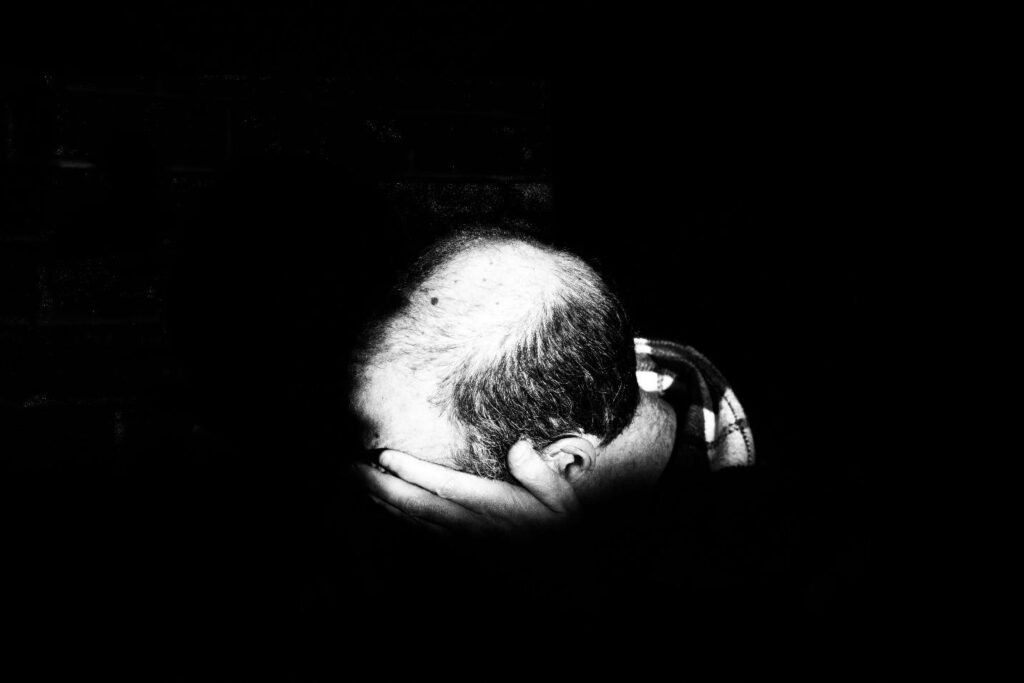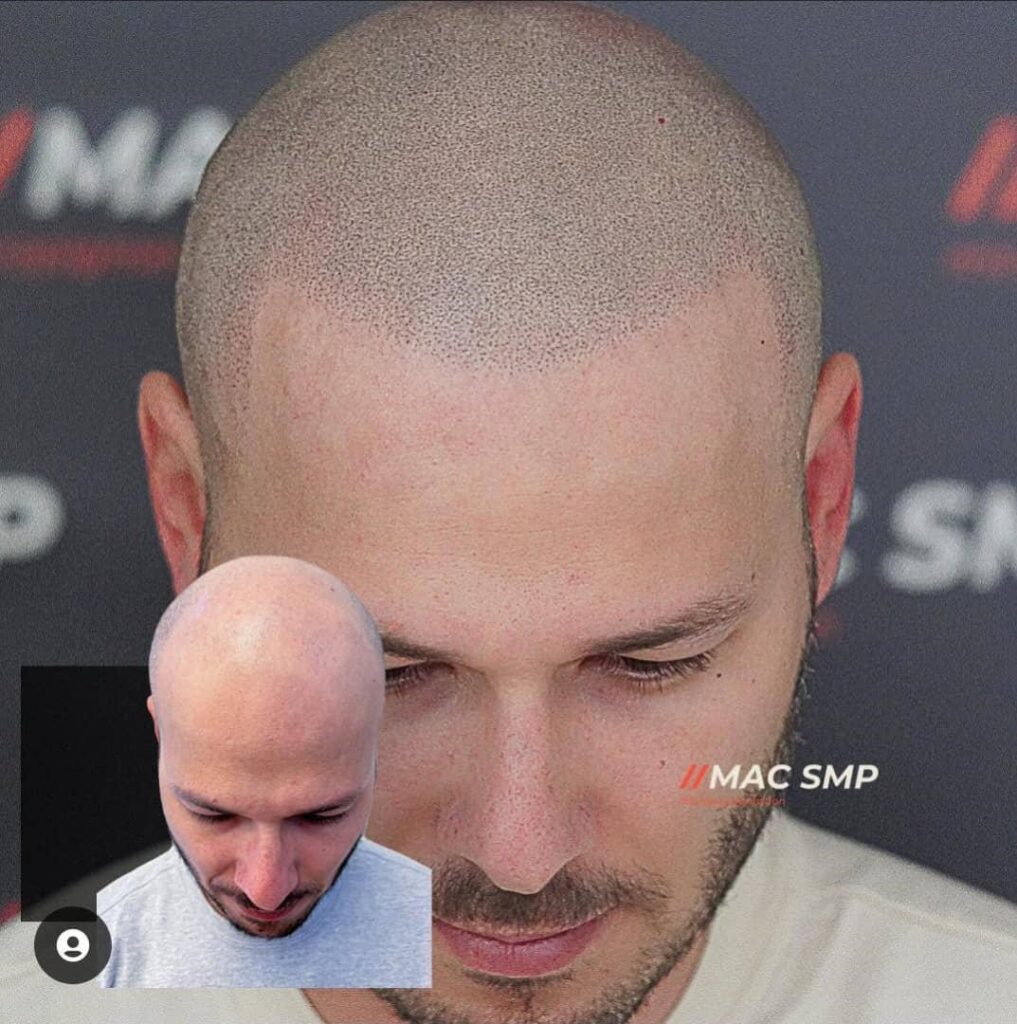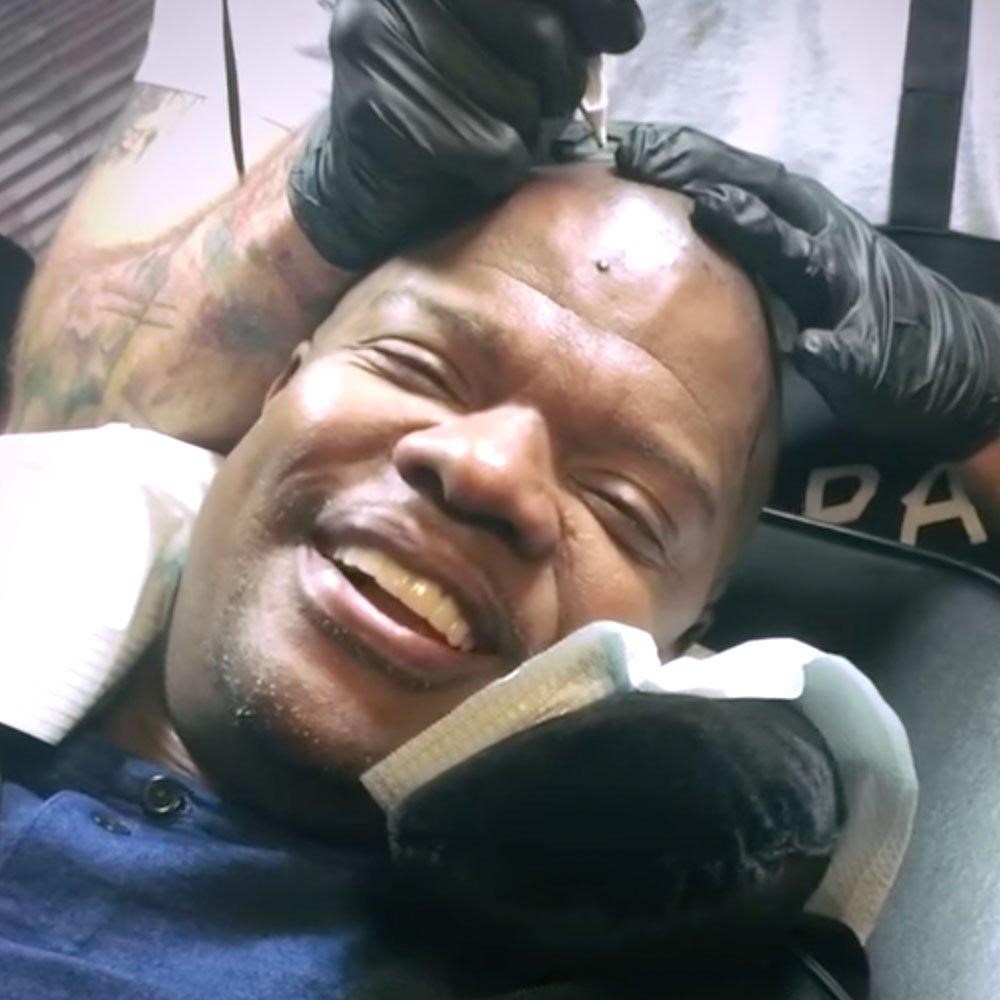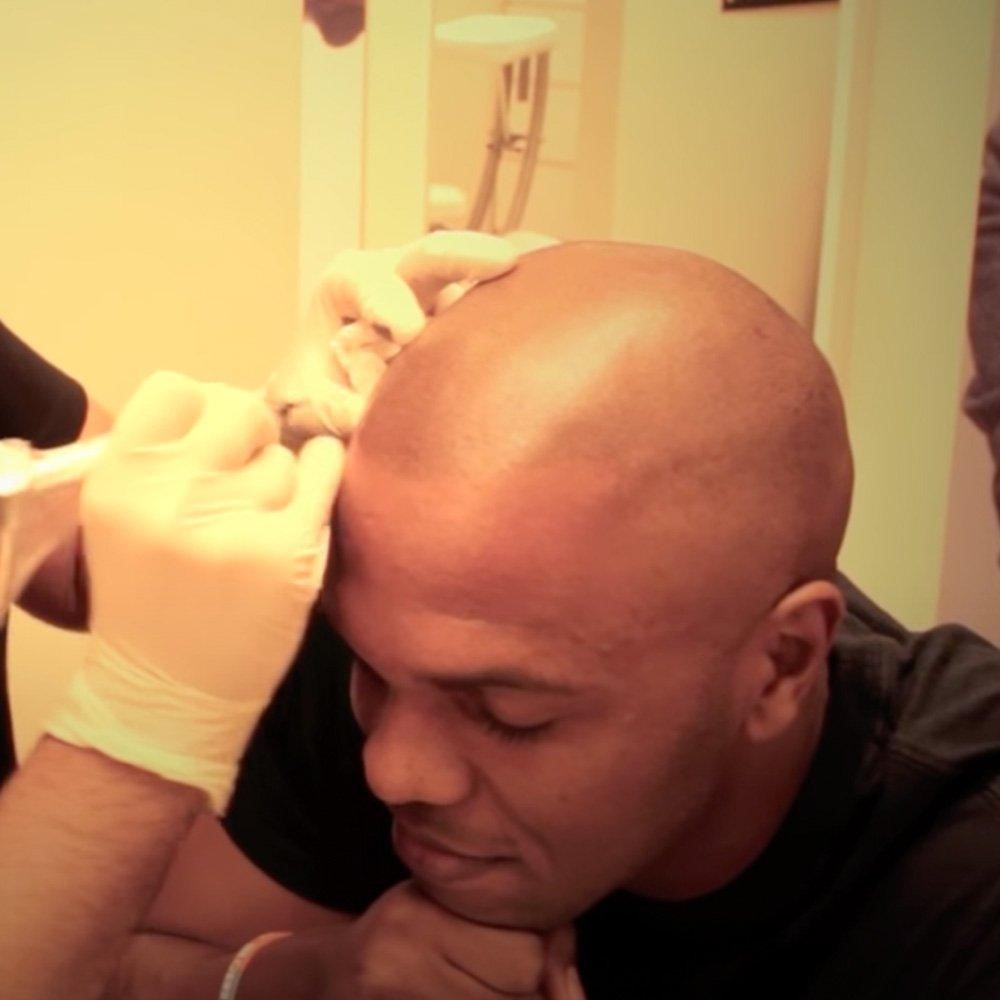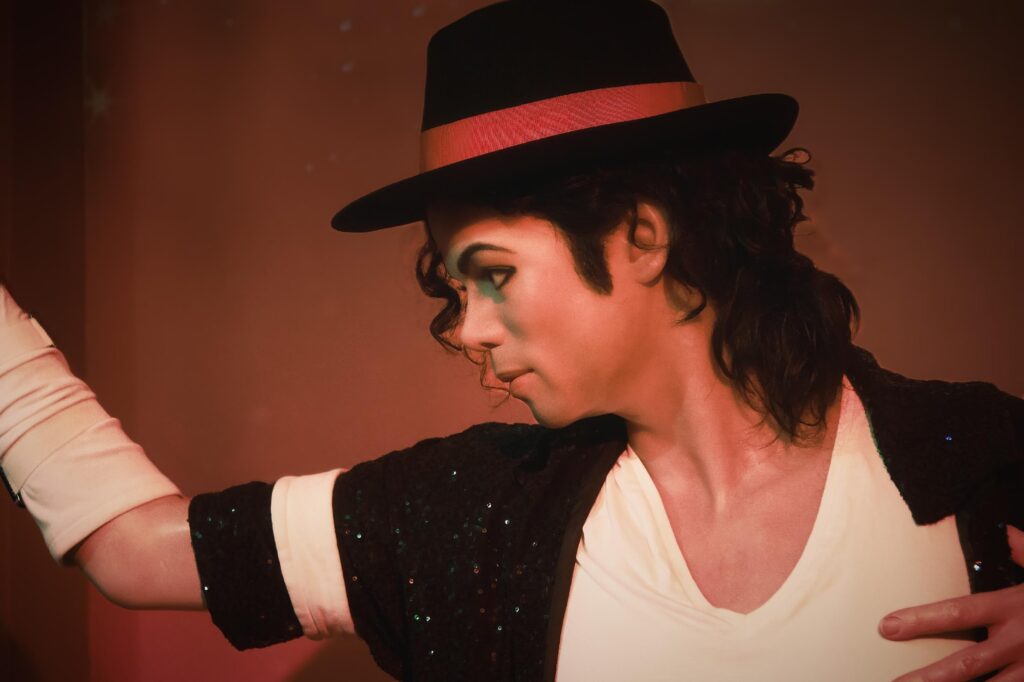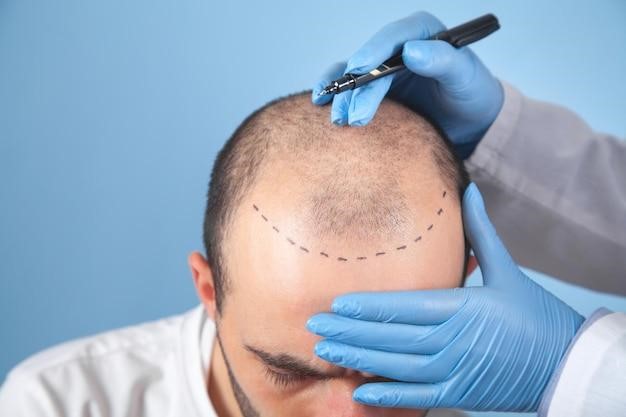As a leading expert in Scalp Micropigmentation, we understand the importance of thorough research and knowledge when considering this cosmetic procedure. In today’s post, we want to delve into the relationship between scalp biopsy and scalp micropigmentation, shedding light on the potential impacts, risks, and aftercare instructions. By the end of this article, you will be equipped with the information needed to make an informed decision about scalp micropigmentation and understand how scalp biopsy can affect the results.
Key Takeaway:
The relationship between scalp biopsy and scalp micropigmentation (SMP) is critical for individuals contemplating SMP. A scalp biopsy, especially if performed in the same area where SMP will be applied, can impact the micropigmentation results.
Scar tissue or changes in skin texture from the biopsy may affect pigment absorption, potentially leading to uneven or less predictable outcomes. It is essential for those who have undergone a scalp biopsy to transparently communicate this information to their SMP practitioner during the consultation phase. This allows for a tailored approach to achieve optimal results while addressing the biopsy’s challenges.
An Overview of Scalp Micropigmentation
Scalp micropigmentation (SMP) is a non-invasive cosmetic procedure that involves the application of specialized pigments to the scalp to create the illusion of a fuller head of hair. This innovative technique is a popular choice for individuals looking to address hair loss, thinning hair, or scarring on the scalp.
Unlike traditional hair transplants, SMP does not require surgery and offers a quick, effective solution for restoring the appearance of a natural hairline and denser scalp.
The process of SMP involves using microneedles to deposit pigments into the upper layers of the scalp, replicating the look of hair follicles. The result is a natural and realistic hairline that can boost confidence and provide a long-lasting solution for hair-related concerns.
With the increasing demand for SMP, it is crucial to consider the factors that may impact the results. Hence, there is a need to examine the relationship between scalp biopsy and SMP.
What is a Scalp Biopsy?
A scalp biopsy is a minor medical or surgical procedure that involves removing a small skin sample from the scalp for examination under a microscope. This procedure is used to diagnose various scalp conditions, including hair loss, infections, and inflammation.
Purposes of a Scalp Biopsy:
- Diagnose hair loss: A scalp biopsy can help to determine the cause of hair loss, such as alopecia areata, alopecia totalis, or scarring alopecia.
- Identify infections: Scalp biopsy can help to identify the presence of infections, such as folliculitis or tinea capitis.
- Evaluate inflammation: Also, a scalp biopsy can help evaluate the presence and severity of inflammation, which may contribute to hair loss or other scalp conditions.
Types of Scalp Biopsy:
- Punch biopsy: A punch biopsy is the most common type of scalp biopsy. It involves using a small, circular instrument to remove a skin sample from the scalp.
- Shave biopsy: A shave biopsy is a less common type of scalp biopsy. It involves using a razor blade to remove a small skin sample from the scalp.
- Incisional biopsy: An incisional biopsy is performed when a larger skin sample is needed for examination. It involves making a small incision in the scalp and removing a strip of skin.
The Procedure of a Scalp Biopsy:
- Preparation: The area of the scalp to be biopsied will be shaved and cleaned.
- Anesthesia: A local anesthetic will be injected into the scalp to numb the area.
- Biopsy: This is the main stage where a sample of skin will be removed using one of the methods described above.
- Closure: The biopsy site will be closed with a bandage or stitches.
Recovery from a Scalp Biopsy:
Most people recover from a scalp biopsy within a few days. The biopsy site may be sore and tender for a few days, and there may be some bleeding. You may need to keep the bandage or stitches dry for a few days.
Risks and Potential Side Effects of Scalp Biopsy
While scalp biopsy is generally considered a safe and routine procedure, it is essential to be aware of the potential risks and side effects associated with the process.
Like any medical intervention, scalp biopsy carries a small risk of complications, including infection, bleeding, and scarring at the biopsy site. Additionally, some individuals may experience minor discomfort or tenderness at the biopsy site following the procedure, which typically resolves within a few days.
It is crucial to follow the healthcare provider’s aftercare instructions to minimize the risk of complications and promote proper healing.
These instructions may include keeping the biopsy site clean and dry, avoiding strenuous activities that could strain the scalp, and using prescribed medications or topical treatments as directed.
Understanding these potential risks and side effects of scalp biopsy can help individuals confidently approach the procedure and prepare for a smooth recovery process.
How Scalp Biopsy Can Affect Scalp Micropigmentation Results
The relationship between scalp biopsy and scalp micropigmentation is essential for individuals contemplating SMP. A scalp biopsy, particularly if performed in the same area where SMP will be applied, can impact the results of the micropigmentation procedure.
The presence of scar tissue or changes in the skin texture resulting from the biopsy can affect the absorption and retention of the pigment, potentially leading to uneven or less predictable outcomes.
Furthermore, the biopsy site’s healing process may influence the scalp’s overall appearance, which can impact the uniformity and naturalness of the SMP results.
Notwithstanding, it is vital for individuals who have undergone a scalp biopsy to communicate this information to their SMP practitioner during the consultation phase. This transparency allows the SMP specialist to assess the biopsy site, discuss potential implications, and develop a tailored approach to achieve optimal results while addressing any challenges posed by the biopsy.
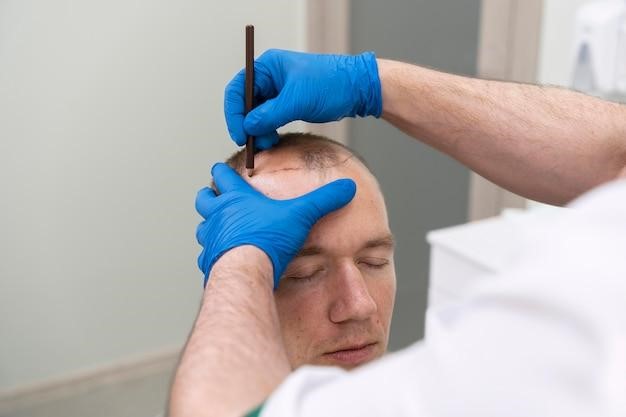
Why Scalp Biopsy is Important Before Scalp Micropigmentation
Scalp biopsy is an important step before Scalp Micropigmentation (SMP) for a few reasons.
First, it helps to ensure that you are a good candidate for SMP. The biopsy will show the health of your scalp and hair follicles, and it can also help to rule out any underlying medical conditions.
Second, the biopsy will help to determine the best SMP technique for you. There are two main types of SMP: follicular unit transplantation (FUT) and follicular unit extraction (FUE). FUT involves removing a strip of scalp from the back of the head, while FUE involves removing individual hair follicles from the back and sides of the head. The biopsy will show how well your hair follicles will transplant, and it can also help to determine the density of the SMP.
Finally, the biopsy will help to establish a baseline for your scalp health. This will allow your doctor to track your progress after the SMP procedure and to make any necessary adjustments to your treatment plan.
Here are some of the things that your doctor will be looking for in the scalp biopsy:
- The overall health of your scalp and hair follicles
- The density of your hair follicles
- The presence of any underlying medical conditions
- The type of scalp tissue
- The level of sebum production
The biopsy is a quick and easy procedure that can be done in your doctor’s office. It is typically performed under local anesthesia with minimal discomfort. The results of the biopsy will be available within a few days.
If you are considering SMP, talk to your doctor about whether or not a scalp biopsy is right for you. The biopsy can help ensure that you are a good candidate for the procedure and get the best possible results.
Scalp Biopsy Aftercare Instructions
Following a scalp biopsy, proper aftercare is essential to promote healing, minimize discomfort, and reduce the risk of complications. The healthcare provider performing the biopsy will provide detailed aftercare instructions tailored to the individual’s specific needs and the type of biopsy performed.
Standard aftercare guidelines may include keeping the biopsy site clean and dry, avoiding exposure to direct sunlight, refraining from vigorous activities that could strain the scalp, and using prescribed medications or topical treatments as directed.
Following the aftercare instructions diligently will support the healing process and optimize the condition of the scalp for future SMP procedures.
People considering scalp micropigmentation after a scalp biopsy should discuss their aftercare experience with their SMP practitioner to ensure that the scalp is optimal for the micropigmentation process.
How Long Does a Scalp Biopsy Take to Heal?
The healing timeline for a scalp biopsy can vary depending on factors such as the biopsy technique used, individual healing capacity, and aftercare adherence. Generally, the initial healing phase, during which the biopsy site closes and begins to form a scab, typically lasts around one to two weeks. During this time, it is crucial to keep the biopsy site clean, dry, and protected from trauma or excessive manipulation.
After the initial healing phase, the skin around the biopsy site may continue to undergo a maturation process, gradually transitioning from forming a scab to developing new skin tissue.
This maturation phase can extend over several weeks, during which the skin may appear pink or slightly raised as it regenerates. Again, it is crucial to follow the healthcare provider’s aftercare instructions diligently during this period to support the complete healing of the scalp and minimize the risk of complications.
Can a Scalp Biopsy Be Wrong?
While scalp biopsy is a valuable diagnostic tool for identifying scalp conditions and guiding treatment decisions, there is a possibility of diagnostic error or inconclusive results.
Factors such as the size and location of the biopsy sample, the proficiency of the laboratory technicians, and the complexity of the underlying scalp condition can contribute to the accuracy of the biopsy findings.
In some cases, a scalp biopsy may yield inconclusive or ambiguous results, requiring further evaluation or additional diagnostic procedures to reach a definitive diagnosis.
Individuals who have undergone a scalp biopsy and have concerns about the accuracy of the results should communicate with their healthcare provider to discuss the possibility of a repeat biopsy or alternative diagnostic approaches.
Open communication and collaboration between the individual and the healthcare team can help ensure the diagnostic process is thorough and comprehensive, guiding informed decisions regarding scalp health and potential cosmetic procedures such as scalp micropigmentation.
Alternative Options for Scalp Micropigmentation Candidates
There are alternative options for scalp biopsy candidates who are uncertain about pursuing scalp micropigmentation due to potential implications.
Hair transplant procedures, topical treatments, and specialized hair care regimens are viable alternatives for individuals seeking to address hair loss, thinning hair, or scalp concerns without micropigmentation. These alternatives may offer different benefits, considerations, and potential outcomes compared to scalp micropigmentation, providing individuals with various choices based on their unique preferences and circumstances.
Considering these other options’ efficacy, potential risks, and long-term results are wise.
Preparing for Scalp Micropigmentation Consultation
When preparing for a scalp micropigmentation consultation, people with a history of scalp biopsy should take proactive steps to facilitate open communication and informed decision-making. Compiling relevant medical records related to the scalp biopsy, including the location, date, and procedure findings, is vital.
These records can provide valuable insights for the SMP practitioner, enabling them to assess the scalp condition, anticipate potential challenges, and tailor the micropigmentation approach to optimize results.
To determine the type of hair loss and assess the affected area, a dermatologist may recommend scheduling an appointment for a scalp biopsy, which involves taking a small amount of tissue sample from the affected region; the choice of biopsy type depends on the specific condition, with telogen effluvium being one example, and the results can provide valuable insights into the potential for hair regrowth.
During the consultation, suitable candidates should be prepared to discuss their scalp biopsy experience, including the healing process, any lingering effects, and their current scalp health status. By providing transparent and detailed information, individuals can empower the SMP practitioner to develop a personalized plan that addresses any concerns related to the scalp biopsy and aligns with the individual’s desired outcomes for scalp micropigmentation.
How Much Does Scalp Biopsy Cost?
The cost of a scalp biopsy can vary depending on factors such as the healthcare provider’s location, the type of biopsy performed, and any additional diagnostic tests or consultations required. In general, you can expect to pay anywhere from $100 to $500 for a scalp biopsy, as the cost may encompass procedural fees, laboratory analysis, follow-up appointments, and any prescribed medications or aftercare products.
That said, healthcare providers or dermatologists specializing in hair and scalp health can provide detailed information about the cost of scalp biopsy, including any associated out-of-pocket expenses and billing processes.
Why You Should Work with Us at Mac SMP
At Mac SMP, we provide exceptional scalp micropigmentation services focusing on personalized care, natural-looking results, and client satisfaction. Our team of experienced SMP specialists understands the complexities of scalp health and the potential impacts of procedures such as scalp biopsy on micropigmentation outcomes. When you choose to work with us at Mac SMP, you can expect:
- Expert Consultations: Our consultations are thorough, informative, and tailored to your unique SMP needs. We prioritize open communication and collaboration to ensure your concerns are heard and your goals for scalp micropigmentation are understood.
- Customized Approaches: We recognize that each individual’s scalp condition is unique, and we specialize in developing customized micropigmentation approaches that account for factors such as skin texture changes and healing considerations. Our tailored strategies are designed to optimize the results of SMP while addressing any challenges posed by scalp biopsy.
- Commitment to Excellence: We are committed to excellence in every aspect of our scalp micropigmentation services. From the precision of pigment application to the artistry of recreating natural hairlines, we prioritize quality, safety, and client satisfaction throughout the micropigmentation process.
Click here to book a free consultation today.
Final Words
Scalp biopsy plays a significant role in the overall success of scalp micropigmentation. Understanding the potential impacts, risks, and aftercare instructions associated with scalp biopsy is crucial for individuals considering SMP.
The healing process and changes in skin texture resulting from a biopsy can influence the absorption and retention of pigments, impacting the uniformity and naturalness of SMP results. Open communication between individuals and SMP practitioners and thorough consultation preparation are key to achieving personalized and satisfactory outcomes.
Enjoy This Article? You May Also Like:
- Tackling the Challenges of Balding Crowns: The What, Why, and How of Balding Crown
- Hair Whorl or Balding? Unveiling 5 Fascinating Facts and Solutions!
- Unraveling the Mystery of a Burning Scalp: Causes and Remedies
- Is a Hairline Tattoo Right for You? 5 Things to Note!
- Ultimate Guide to Hairline and Scalp Tattooing
